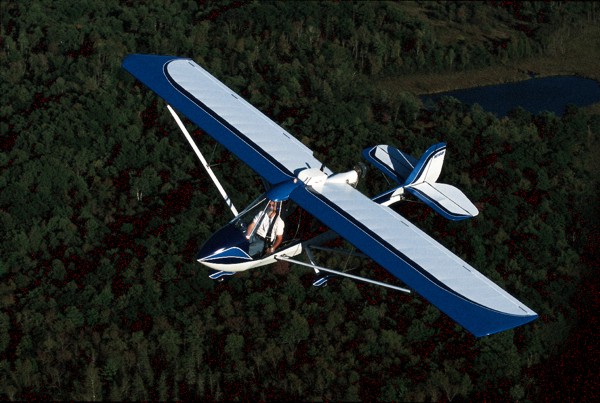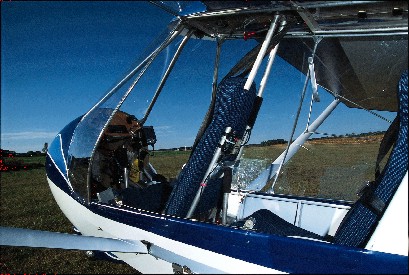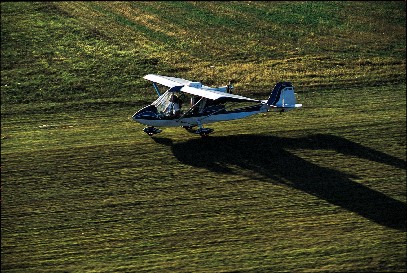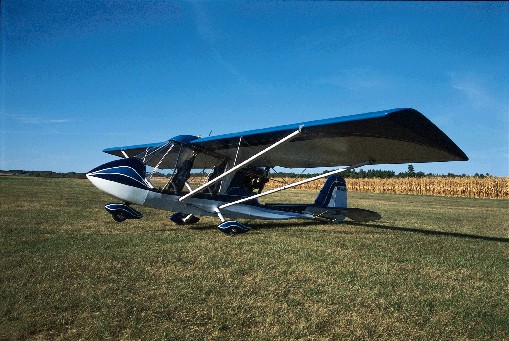

According to the author, the Challenger boasts a surprisingly roomy cockpit, which is due in part to the fact that the design
features tandem seating.

The panel is small, but there’s enough room for basic instrumentation.

The Challenger’s fuel tank rests behind the rear seat, which is folded forward in this photo.

First-time builder Allen Mader completed his Challenger in 700 hours, but he says that the process could have been quicker.

The author says landings are easy and
recommends a final approach at 30-35 mph. The plane retains energy so well that pilots who come in too fast will end up floating excessively before touchdown.

Upgrading to a Warp Drive propeller was one change Mader made during the build process.

Mader opted to install a BRS airframe
parachute in his aircraft.

To activate the ‘chute, the pilot simply pulls the red handle mounted directly above the front seat.

Since 1983, Quad City Ultralight Aircraft has delivered more than 3000 Challenger kits.
For 21 Years, Quad City’s Challenger has proved a good choice.
It’s enough to create a serious case of envy among producers vying for the market the Challenger seems to own year after year. Even in 2003, a slow year for all aircraft manufacturers, Quad City Ultralight Aircraft pumped out another 120 kits. Most light-sport aviation companies would consider that an excellent performance. For Quad City, it was a down year!
The venerable company from the Quad Cities area of Iowa, near the Illinois border, has put more than 3000 aircraft in the air. Van’s Aircraft has done even better, and Quicksilver has more than 10,000 ultralights flying, but the Challenger is clearly one of the industry’s leaders. And the company has enjoyed the same leadership since it was founded more than two decades ago.
Despite this success, Quad City maneuvers rather quietly. Last year the company celebrated 20 years of operation, yet many ultralighters and most aviators were unaware of the accomplishment. And this year, Quad City reached another milestone with the 20th anniversary of the two-seaters that have made up the majority of its production.
The Demo Plane Duo
For this review I had a chance to fly two different two-seat Challengers. One was built by Al Mader, a middle school art teacher in Medford, Wisconsin. Though Mader instructs seventh and eighth grade students (a task most pilots wouldn’t dare attempt), he had never before built an aircraft. He took his time and got it right.
“With all the head scratching I did,” Mader says, “it took me more than 700 hours to build the plane. It wouldn’t have to take that long.”
Indeed Quad City’s fastbuild kit is one of the Challenger’s strongest sales arguments. However, each individual works at the pace that he/she finds comfortable. Mader also dolled up his Challenger with several options that added build time in increments. For example, he has the special leading-edge treatment that places a wide cut of aluminum sheet over the entire wingspan reaching from the underside and wrapping around to 12 inches aft of the leading-edge spar.
“It gets rid of the scalloping that happens between ribs without the metal,” he says.
In addition, Mader installed wheelpants, a three-blade Warp Drive propeller, Quad City’s fiberglass nosecone, an ELT, the factory Hoerner wingtips, an EIS engine monitor and a parachute system. With all these deluxe options, Mader’s Challenger weighs 500 pounds empty—but empty weight can be much less. He’s flown lighter versions and feels like so many other ultralight pilots who have experience in lighter and heavier versions of the same model.
“If I did it all over again, I would make the plane as light as possible,” Mader admits. “The lighter ones fly better.”
Mader received his first taste of ultralights with Don Zank of Zanklites, who also sold him the kit. A 4000-hour pilot in Challengers alone, Zank is one of the country’s most experienced dealers for the Iowa producer. He also represents Titan and Loehle aircraft and may become the man behind the Patriot [see the “Dreams of a Patriot” sidebar]. Headquartered in Bloomer, Wisconsin, at the Gateway airport he now owns, Zank works with many area pilots to whom he sells aircraft.
And for years, Zank has been the face of Quad City at Oshkosh AirVenture. Though he handles the other brands, Challengers are still the backbone of his enterprise, and he now runs the company’s display at the big summer event. When I flew with him, I saw a pilot in good harmony with his flying machine and one who remains excited about them after all those flight hours—maybe its because of all those flight hours.
Successful Company, Successful Design
The truth of Quad City’s success may be revealed by this grudgingly complimentary statement by a competing manufacturer: “They [Quad City] build a low-cost ultralight and deliver it swiftly.” For more than two decades, the company has been satisfying pilots and challenging its competitors.
Quad City supplies an airworthy machine that brings flying enjoyment combined with an unusual ease of building—the company does a substantial part of the assembly, saving the builder considerable hours. Quality and flight characteristics notwithstanding, consistently low prices and quick shipments surely are a big part of Quad City’s success.
Halfway into its current life span, the design sought to win British certification under the U.K.’s BCAR-S program for microlight aircraft—a demanding task nearly equivalent to earning FAR Part 23 certification. Although a few modest changes were made (Quad City increased the height of the vertical stabilizer), British authorities eventually gave their stamp of approval. Though Americans don’t use the Civil Aviation Authority’s system, winning British certification will reassure many buyers.
To me, one of the most endearing qualities of the Challenger is its light weight when compared to many ultralights. A two-seat Challenger with basic but sufficient equipment tips the scales at barely more than 300 pounds empty. You can build a single-seat model that weighs almost 20 pounds less than the FAA’s 254-pound limit for Part 103 (which, by the way, is not going away with the arrival of the sport-pilot/light-sport aircraft (LSA) proposal).
As Mader came to learn from his building and flying experience, light weight benefits handling and low-speed performance. The slower speed realm of ultralights is an endearing capability, and keeping weight low is one of the best ways to ensure these capabilities.
But while Challengers can be light, they are also surprisingly roomy— partly a benefit of tandem seating. If you want a plane that won’t squeeze you, here it is. Especially with doors that curve outward to add dimension, Mader’s plane was roomy. In a tandem aircraft, no one rubs elbows with you or blocks your vision to either side.
Challengers are quite maneuverable on the ground. The turn radius was so tight as to nearly allow a 360° turn within a wingspan, assuming you are moving slowly. The inside maingear wheel appeared to scribe a circle only a few feet in diameter. Most pilots appreciate crisp taxiing, and it is certainly handy on a crowded airport ramp.
In-Flight Characteristics
Having taxied to the proper end of Gateway Airport’s north/south runway, I added power. Following a brief ground roll, we rotated at barely more than 30 mph indicated, and we were flying.
After a couple takeoff and landings, I was reminded how easily the Challenger goes into the air and just as simply returns to the runway. Controls are cooperative and have no touchiness to them. Advice I’d been given earlier still applied, namely that you can approach at 30-35 mph and you shouldn’t let it exceed 50 mph. The plane retains energy quite well in ground effect such that at 60 mph, you’d float excessively before getting it on terra firma.
When I later flew with Zank, he demonstrated one of the deepest, slowest slips I have ever seen in any aircraft. It felt like we were descending vertically yet on releasing the controls, the Challenger simply started flying as though no changes had ever been made.
Despite their easy handling during takeoff and landing, Challengers exhibit an odd adverse yaw quality. When sampling the reaction to aileron-only input with no rudder control application, Zank’s Challenger went around an entire circle the wrong way assuming you do not release the control input. Naturally, you wouldn’t hold them this way as I did, and when controlled in a conventional manner, the Challenger shows the conventional handlingcharacteristics.
Fortunately the good aspects of the Challenger’s handling are many. Coordinated control authority is strong, allowing operations even in strong crosswind conditions. Control pressures are light, keeping pilot fatigue to a minimum. In general, the Challenger exhibited good response in all axes, and harmony was quite reasonable. But you must use the controls together, just as your instructor taught you.
It’s easy to design crisp handling at higher cruise speeds, but the Challenger particularly shines at slow-speed handling, superior to many other designs. And it is the slow speed ability of ultralights that charms many pilots. Even with the eventual arrival of LSA, it is low-and-slow flying that remains the domain of ultralight aviation, and the Challenger does particularly well in this regime.
However, the low-speed capability doesn’t prevent the aircraft from offering speeds with more zip. When you push the nose over, the design moves out smartly. In level flight with higher power settings, I noted airspeed can accelerate beyond 70 mph. At full throttle or with a larger engine, Challengers can hit 100 mph (their Vne).
The light weight of the design also helps in performance areas like takeoff ground roll and reduced-power descents. The idle-thrust sink rate of a lightly built Challenger can be as low as 400 fpm, better than many ultralight designs. Should your engine take a vacation, you’ll appreciate the extra time aloft to determine your approach.
Long in the Saddle
After 20 years of market success with many aircraft flying at airfields across the country, Challengers boast an enviably good safety record. You simply don’t hear of many problems with the design, and it rarely shows up in serious accident reports.
A good preliminary design with long and slow evolution, careful quality control, understandable builder instructions and corrections to known deficiencies are all desirable goals of any aircraft manufacturer. However, even well-designed aircraft can still have problems. The Challenger’s low level of incidents may say more than all the testing or any number of product evaluations. If pilots don’t often crash in a plane when measured over a long time, most experts would agree that the engineering must be up to the task.
Lower speeds and low kinetic energy are strong attributes of ultralight aircraft. The Challenger line, especially the longer-winged models, makes good use of these energies. Since the ultralight is docile at slow speeds, I was able to deliberately miscontrol the airplane in the low 30s—it just wanted to keep flying.
In more conventional verifications, I performed a longitudinal stability series of pushing or pulling the stick and releasing. Some designs will return to level flight faster than the Challenger, but the design was positive in all such checks.
I also tried stalls in all the usual configurations (power off, power on and accelerated). All were mild. When the wing does quit flying, the Challenger seems to pivot at the top, lower its nose a bit and then resume flying as if the stall never happened.
In an earlier flight test, I tried to spin the Challenger after Zank told me I wouldn’t be able to do it. For the most part he was right, though I was able to get a modest partial spin to the right. Virtually confirming his confidence, the Challenger flew itself out of the spin even though I tried to hold it.
A Fair Challenge
In an age when light-sport airplane costs are zooming upward well beyond $50,000, Challenger remains a bargain. Plus you can get one rather quickly should you make the decision to buy. As long as Zank has represented the company, the worst delay he ever experienced was 90 days. Normally 60 days is plenty for delivery, and it can be much faster depending on the model you want and the time of year.
Challengers are available in four configurations:
•Ultralight—and yes, it can qualify for Part 103 if you build carefully.
•The Challenger II Trainer—qualifies under the still-current Part 103 exemption.
•The Special single-seater and the Challenger II Special—both must have N-numbers.
The Special models are clipped-wing, higher-speed performers. They also tend to be equipped as more deluxe versions coming standard with features like the flaperon system, faired struts, wheelpants, a larger fuel tank and a complete door kit. Naturally, these extras add weight and cost over the basic models.
The Ultralight model sells from $10,700 to $13,800, depending on which engine you choose. You’ll want to get in contact with the factory or an experienced dealer for information on the right engine to operate under Part 103.
The two seat Trainer models run from $12,900 to $16,400, and even these figures are low among two-seat aircraft. With his many options—including a $3000 parachute—Mader reports investing $18,000 for his optioned out Challenger. Even at that expense, you could afford a small fleet of Challengers for the price of one fiberglass model from Europe.
Zank likes to add his own selling points: “All Challengers are effectively quickbuild kits. The factory handles all the more demanding structural work, including installing the controls.” Most companies charge a considerable extra fee for their quickbuild option.
“First timers usually take less than 300 hours to complete the assembly including covering and painting,” Zank says. Once your Challenger has been completed, it only takes a half hour or so to remove or reinstall the wings for storage or trailering.
The price of quickbuild kits for the Challenger, which include the engine and all covering materials except paint, haven’t gone up significantly in the last decade. The reason for this may be that the design is evolving rather than radically changing. You’ll want to compare costs carefully, as most other kit manufacturers publish price lists that exclude the engine just as they charge a premium for quickbuild versions.
Mader offers his own advice on the subject. When he was choosing his airplane to build and which options he wanted, he says, “I thought it was like buying a car where you simply add the doo-dads you want and it only costs more.” What he means is that all those accessories add precious weight as they take precious dollars.
For pilots on a budget, the Challenger offers a good value, no question. The quartet of models has also satisfied a large number of customers by providing a handling and performance package with a strong safety record. And with dealers across the country, Quad City’s Challenger line represents a firmly established brand, so building and maintaining your Challenger should be a straightforward task. It seems as if Quad City Ultralight Aircraft has covered all the bases important to recreational pilots.
FOR MORE INFORMATION, contact Quad City Ultralights at 309/764-3515 or visit www.quadcitychallenger.com. For Zanklites, call 715/568-2244 or e-mail donzank@zanklites.com.
| Seating | 2, tandem |
| Empty weight | 320 pounds/360 pounds 1 |
| Gross weight | 800 pounds/850 pounds |
| Wingspan | 31.5 feet/26.0 feet |
| Wing area | 173 square feet/143 square feet |
| Wing loading | 4.6/5.9 pounds/square foot |
| Useful Load | 480 pounds |
| Length | 20 feet, both models |
| Payload (with full fuel) | 420 pounds |
| Height | 6 feet, both models |
| Fuel Capacity | 10 gallons |
| Notes: | 1 The first set of numbers is for the long-wing Challenger II Trainer, the second set is for the clipped-wing Challenger II Special. |
| Standard engine | Rotax 503 Dual Carb 1 |
| Power | 52-hp |
| Power loading | 12.1 pounds/hp |
| Max Speed | 100 mph |
| Cruise speed | 70 mph |
| Stall Speed | 33 mph |
| Rate of climb at gross | 900 fpm |
| Takeoff distance at gross | 200 feet |
| Landing distance at gross | 200 feet |
| Notes: | 1 Performance specs as tested for the Challenger II Trainer. Standard engine is Rotax 447 (40-hp). |


Can I remove the vertical stabilizers from my horizontal stabilizer?
That sounds like a modification used for float flying (a common remedy). However, I lack expertise to advise you about removing them. I suggest a Facebook page for Challenger. Some other owner(s) may know.